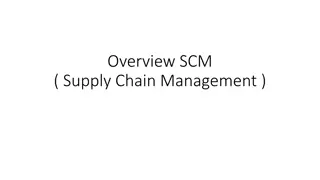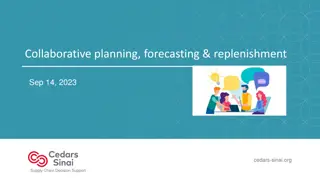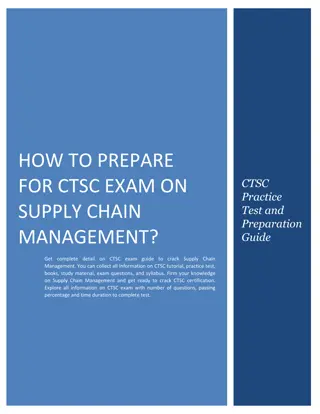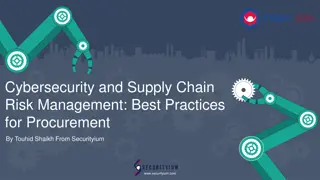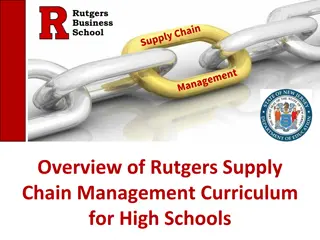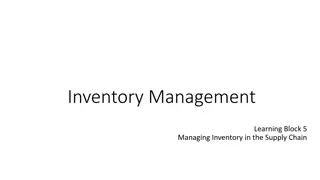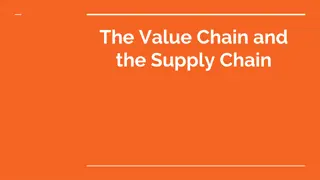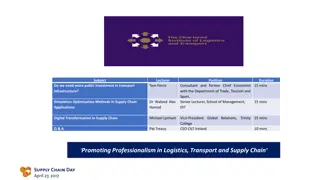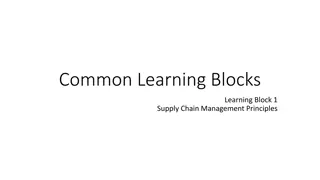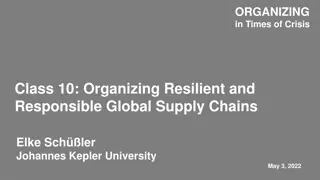Understanding Supply Chain Management: Key Concepts and Processes
Supply chain management (SCM) involves the centralized management of goods and services flow, covering processes from raw materials to final products. By efficiently managing the supply chain, companies can reduce costs and improve product delivery. This seminar presentation explores the definition, working principles, and parts of SCM, along with different supply chain models. It emphasizes the importance of planning and coordination in optimizing supply chains for better business outcomes.
Download Presentation

Please find below an Image/Link to download the presentation.
The content on the website is provided AS IS for your information and personal use only. It may not be sold, licensed, or shared on other websites without obtaining consent from the author. Download presentation by click this link. If you encounter any issues during the download, it is possible that the publisher has removed the file from their server.
E N D
Presentation Transcript
SeminarPpt.com Seminar On SUPPLY CHAIN MANAGEMENT Submitted to: Seminarppt.com Submitted By Seminarppt.com
Table Contents Introduction Definition Working of Supply Chain Management Parts of Supply Chain Management Types of Supply chain Models Conclusion 2
Introduction Supply chain management (SCM) is the centralized management of the flow of goods and services and includes all processes that transform raw materials into final products. By managing the supply chain, companies can cut excess costs and deliver products to the consumer faster and more efficiently. 3
Definition Supply chain management is the management of the flow of goods and services and includes all processes that transform raw materials into final products. 4
Working of Supply Chain Management Supply chain management (SCM) represents an effort by suppliers to develop and implement supply chains that are as efficient and economical as possible. Supply chains cover everything from production to product development to the information systems needed to direct these undertakings. 7
Working of Supply Chain Management By managing the supply chain, companies can cut excess costs and deliver products to the consumer faster. This is done by keeping tighter control of internal inventories, internal production, distribution, sales, and the inventories of company vendors. 8
Working of Supply Chain Management SCM is based on the idea that nearly every product that comes to market results from the efforts of various organizations that make up a supply chain. Although supply chains have existed for ages, most companies have only recently paid attention to them as a value-add to their operations. 9
Parts of Supply Chain Management Planning To get the best results from SCM, the process usually begins with planning to match supply with customer and manufacturing demands. Firms must predict what their future needs will be and act accordingly. 10
Parts of Supply Chain Management Sourcing Efficient SCM processes rely very heavily on strong relationships with suppliers. Sourcing entails working with vendors to supply the raw materials needed throughout the manufacturing process. A company may be able to plan and work with a supplier to source goods in advance. 11
Parts of Supply Chain Management Manufacturing At the heart of the supply chain management process, the company transforms raw materials by using machinery, labor, or other external forces to make something new. This final product is the ultimate goal of the manufacturing process, though it is not the final stage of supply chain management. 12
Parts of Supply Chain Management Delivering Once products are made and sales are finalized, a company must get the products into the hands of its customers. The distribution process is often seen as a brand image contributor, as up until this point, the customer has not yet interacted with the product. 13
Parts of Supply Chain Management Returning The supply chain management process concludes with support for the product and customer returns. Its bad enough that a customer needs to return a product, and its even worse if its due to an error on the company's part. 14
Types of Supply Chain Models Continuous Flow Model: One of the more traditional supply chain methods, this model is often best for mature industries. The continuous flow model relies on a manufacturer producing the same good over and over and expecting customer demand will little variation. 15
Types of Supply Chain Models Agile Model: This model is best for companies with unpredictable demand or customer-order products. This model prioritizes flexibility, as a company may have a specific need at any given moment and must be prepared to pivot accordingly. 16
Types of Supply Chain Models Fast Model: This model emphasizes the quick turnover of a product with a short life cycle. Using a fast chain model, a company strives to capitalize on a trend, quickly produce goods, and ensure the product is fully sold before the trend ends. 17
Types of Supply Chain Models Flexible Model: The flexible model works best for companies impacted by seasonality. Some companies may have much higher demand requirements during peak season and low volume requirements in others. A flexible model of supply chain management makes sure production can easily be ramped up or wound down. 18
Types of Supply Chain Models Efficient Model: For companies competing in industries with very tight profit margins, a company may strive to get an advantage by making their supply chain management process the most efficient. This includes utilizing equipment and machinery in the most ideal ways in addition to managing inventory and processing orders most efficiently. 19
Types of Supply Chain Models Custom Model: If any model above doesn't suit a company's needs, it can always turn towards a custom model. This is often the case for highly specialized industries with high technical requirements such as an automobile manufacturer. \ 20
Future of SCM The supply chain of the future is all about responsiveness and the customer experience understood and managed within a network rather than a linear model. Every node of the network must be attuned and flexible to the needs of the consumer while also being capable of addressing factors such as sourcing, trade policies, modes of shipment, and more. Advanced technology will increasingly be used to improve transparency and visibility throughout this network, as well as to further enable connectivity and SCM utilization. \ 21
Conclusion Supply chain management is the practice of coordinating the various activities necessary to produce and deliver goods and services to a business s customers. Examples of supply chain activities can include designing, farming, manufacturing, packaging, or transporting. 22
References Wikipedia.org Google.com Seminarppt.com Studymafia.org



